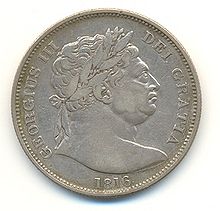TheGreat Recoinage of 1816was an attempt by the government of theUnited Kingdom of Great Britain and Irelandto re-stabilise its currency, thepound sterling,after the economic difficulties brought about by theFrench Revolutionary Warsand theNapoleonic Wars.[1]


Background
editTheFrench Revolutionary Wars(1792–1802) and theNapoleonic Wars(1803–1815) led to financial instability in Britain. This was due to the cost of direct military and economic warfare against France as well as Britain's financing of a series of coalitions opposed to theFrench RevolutionaryandNapoleonicregimes. In exchange for large cash subsidies from Britain, nations such as Austria, Prussia and Russia, with armies larger than Britain's, fought against France. The period's economic conflicts, such as Napoleon'sContinental Systemand Britain's retaliatory measures against it, disrupted trade and the availability of markets in Europe for the products of Britain's growing mercantile and colonial empires. Finally, insufficient supplies of silver and copper led to a shortage of coins.
Privately owned banks in Great Britain and Ireland had long been free to issue their ownbanknotes,but as gold shortages affected thesupply of money,the note-issuing powers of the banks were gradually limited by variousActs of Parliament,until theBank Charter Act 1844limited the issuance by English and Welsh banks of non-gold-backedBank of Englandnotes to up to £14 million.[note 1]The English private banknote eventually disappeared, leaving the Bank of England with a monopoly of note issue in England and Wales.[3]
Local tokenswere produced by companies and banks all over the country. Despite an increase in trade,the national debthad increased by 100% by the start of the 19th century. A series of bad harvests pushed upfood pricesand this culminated in riots in 1801–02.
Corn prices[note 2]halved at the end of the wars, when trade with Europe resumed. TheCorn Laws of 1815were intended to protect the price of domestic grain, but this kept grain prices high and depressed the domestic market formanufactured goods,because people had to use so much of their money to buy food.[4]Likewise, European countries that relied on exporting corn to Britain in order to buy British manufactured goods were no longer able to do so.
The government needed to find a way to stabilise the currency, and the Great Recoinage was the first step in this process. The main aims were the reintroduction of a silver coinage and a change in the gold coinage from theguineavalued at 21shillingsto the slightly lightersovereignworth 20 shillings.[5]The value of the shilling remained unchanged at twelvepence.[6]
This massive recoinage programme by theRoyal Mintcreated standard gold sovereigns and circulatingcrownsandhalf-crownscontaining the now famous image ofSt. George and the Dragonby the Italian engraverBenedetto Pistrucci,[7]and eventuallycopper farthingsin 1821. Pistrucci's initial portrait ofGeorge IIIhas become known to collectors as the "bull-head George".
Specifications
editThe weight of the new gold sovereigns was calculated on the basis that the value of onetroy poundof standard (22carat) gold was £46 14s 6d.[note 3]Sovereigns therefore weighed 123.2745grains(7.98805 grams). This standard persists to the present day, more than two centuries later. To put agold standardinto effect, and avoid the pitfalls ofbimetallism,silver coins were declaredlegal tenderonly for sums of money up to £2.[note 4]
The recoinage of silver in Great Britain after a long drought produced a burst of coins: the mint struck nearly 40 million shillings between 1816 and 1820, 17 million half-crowns and 1.3 million silver crowns.[9]
The value of one troy pound (weighing 5,760 grains (373 g) of standardsterling silver(0.925fineness)) was fixed by coining it into 66 shillings (or its equivalent in other denominations). This established the weight of all silver coins (and theircupro-nickelsuccessors), and their decimal new pence replacements, from 1816 until the 1990s, when new smaller coins were introduced.
The silver coins initially produced were shillings weighing 87.2727 grains (5.65518 g), half-crowns of 218.1818 gr (14.13794 g) and crowns of 436.3636 gr (28.27589 g). Over the many reigns untildecimalisationother denominations came and went, such as thethreepence,sixpence,florin,anddouble florin,always weighing exactly one troy pound per 66 shillings (irrespective of fineness, which was reduced to 50% in 1920, and to 0% in 1947). This made 5 sterling silver shillings (which is 1 crown), about the weight of.9091 troy ounce of sterling silver.
See also
editExplanatory notes
editReferences
edit- ^A New history of the Royal Mintby Christopher Edgar Challis
- ^United KingdomGross Domestic Product deflatorfigures follow theMeasuringWorth"consistent series" supplied inThomas, Ryland; Williamson, Samuel H. (2018)."What Was the U.K. GDP Then?".MeasuringWorth.RetrievedFebruary 2,2020.
- ^"A brief history of banknotes".Bank of England. Archived fromthe originalon 11 October 2007.Retrieved8 October2007.
- ^Bright, J. and Thorold Rogers, J. E. (eds.) [1870] (1908)Speeches on Questions of Public Policy by Richard Cobden, M.P.,Vol. 1, London: T. Fisher Unwin, republished as Cobden, R. (1995), London: Routledge/Thoemmes,ISBN0-415-12742-4
- ^The British Almanac.Society for the Diffusion of Useful Knowledge (Great Britain) 1856
- ^The Coinage of Britain.Ken Elks
- ^A New History of the Royal Mint.Christopher Edgar Challis
- ^abUKRetail Price Indexinflation figures are based on data fromClark, Gregory (2017)."The Annual RPI and Average Earnings for Britain, 1209 to Present (New Series)".MeasuringWorth.RetrievedMay 7,2024.
- ^Report from the Select Committee on the Royal Mint: together with the minutes of evidence, appendix and index, Volume 2(Great Britain. Committee on Royal Mint, 1849), p. 172.